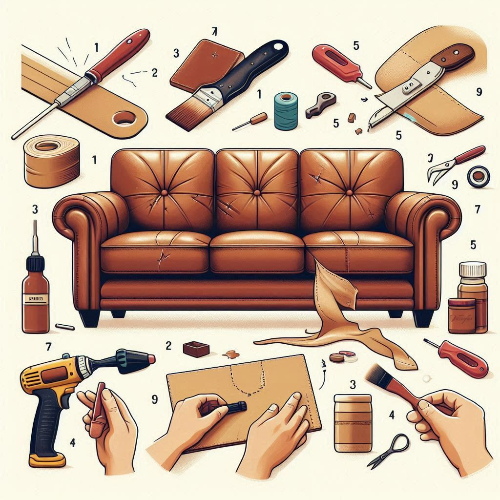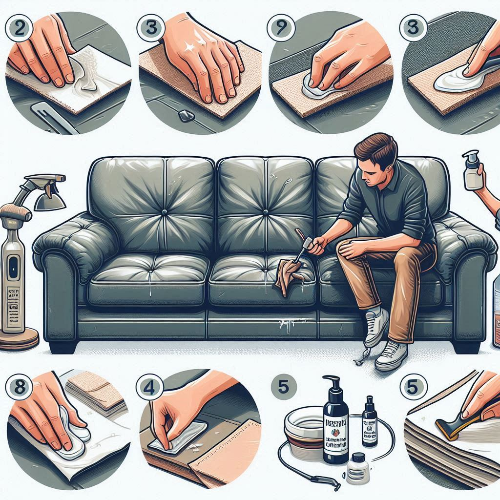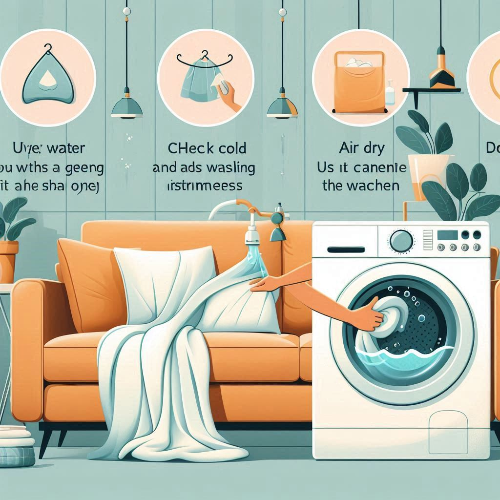How to Repair a Leather Sofa
How to repair leather sofa? Leather sofas are luxurious additions to any living space, adding a touch of elegance and sophistication. However, over time, wear and tear can take a toll on your leather couch, leading to scratches, tears, and other damage. In this guide, we will explore various techniques for repairing and maintaining your leather sofa to keep it looking as good as new.
Understanding Leather Damage
Before attempting to repair your leather sofa, it’s important to understand the types of damage it may have sustained. Scratches, tears, and fading are common issues that can detract from the beauty of your couch. By assessing the extent of the damage and identifying the causes, you can determine the best course of action for repair.
Identifying Types of Damage
Scratches and tears are among the most common types of damage that leather sofas may experience. Scratches can range from minor surface marks to deeper gouges, while tears can vary in size and location. Additionally, color fading and wear on the leather surface are also issues that may need to be addressed.
Determining the Extent of the Damage
Once you have identified the types of damage present on your leather sofa, assess the extent of the harm. Determine whether the damage is limited to the surface or if it has penetrated deeper layers of the leather. Understanding the scope of the damage will help you choose the most effective repair techniques.
Common Causes of Leather Damage
Leather damage can be caused by various factors, including sharp objects, pets’ claws, direct sunlight exposure, and general wear and tear. By knowing the common causes of leather damage, you can take steps to prevent future harm and prolong the lifespan of your leather sofa.
DIY Leather Repair Techniques
For minor leather sofa repairs, do-it-yourself techniques can be effective in restoring the beauty of your furniture. Using a leather repair kit, you can address scratches, tears, and other minor damages without the need for professional intervention.
Using a Leather Repair Kit
A leather repair kit typically includes materials such as filler, adhesive, colorant, and tools needed to repair common leather damages. Follow the instructions provided in the kit to fill in scratches, tears, or holes, and blend the color to match the surrounding leather seamlessly.
Repairing Scratches and Tears
For small scratches and tears, apply a thin layer of leather glue to seal the damaged area. Smooth out the adhesive and allow it to dry completely before touching the repaired spot. For larger tears, consider using a leather patch to cover and reinforce the damaged section.
Applying Leather Conditioner
After completing the repair process, it’s essential to apply a leather conditioner to restore moisture and suppleness to the repaired area. Conditioning the leather regularly will help maintain its durability and prevent future damage.
Fixing Tears and Patches
For more significant tears and patches on your leather sofa, additional repair techniques may be necessary. Sewing tears and applying leather patches are effective methods for fixing larger damages and ensuring the longevity of your couch.
Sewing Techniques for Tears
To repair tears in leather, carefully stitch the edges of the tear together using a strong, durable thread. Ensure the seam is secure and blends seamlessly with the surrounding leather to create a neat and professional repair.
Applying Leather Patches
When dealing with sizable tears or holes in your leather sofa, consider using leather patches to cover and reinforce the damaged area. Match the color and texture of the patch to the original leather for a seamless repair that preserves the appearance of the couch.
Dealing with Colored Leather
If your leather sofa features colored leather, ensure that any patches or repairs are done using materials that match the existing color. Pay attention to the color saturation and finish to make the repair blend in with the rest of the couch seamlessly.
Preventing Future Damage
Proper care and maintenance are crucial in preventing future damage to your leather sofa. By following a few simple tips and avoiding common mistakes in leather repair, you can extend the lifespan of your furniture and keep it looking pristine for years to come.
Proper Leather Care and Maintenance
Regularly clean your leather sofa with a suitable cleaner and conditioner to remove dirt and maintain its softness and luster. Avoid using harsh chemicals or abrasive cleaners that can damage the leather surface and cause premature wear.
Avoiding Common Mistakes in Leather Repair
When attempting DIY leather repairs, avoid common mistakes such as using the wrong type of adhesive or overfilling scratches and tears. Follow the repair instructions carefully and seek professional help if you encounter complex damages beyond your expertise.
Tips for Extending Leather Sofa Lifespan
To prolong the life of your leather sofa, position it away from direct sunlight to prevent fading and drying out of the leather. Rotate cushions regularly to distribute wear evenly, and maintain a consistent humidity level to prevent cracks and damage to the leather.
Professional Leather Repair Services
While many leather sofa issues can be resolved through DIY techniques, there are times when professional intervention is necessary. Knowing when to seek professional help, how to choose the right leather repair specialist, and understanding the cost factors involved are essential when considering professional leather repair services.
When to Seek Professional Help
If your leather sofa has extensive damage, intricate stitching requirements, or specialized repairs, it’s best to consult a professional leather repair service. Professionals have the expertise and tools to handle complex leather damages effectively.
Choosing the Right Leather Repair Specialist
When selecting a leather repair specialist, look for experience, certification, and positive reviews from previous clients. Ensure the specialist is knowledgeable in working with various types of leather and can provide references for their work quality.
Cost Factors in Leather Sofa Repair
The cost of leather sofa repair services may vary depending on the extent of the damage, the type of repair needed, and the professional’s reputation. Consider obtaining multiple quotes, reviewing the services included, and comparing the costs before making a decision on leather repair services.
Frequently Asked Questions
Q: What is the best way to repair a tear in a leather couch?
A: The best way to repair a tear in a leather couch is to use a complete leather repair kit like Coconix, which usually includes all the necessary tools and materials for the job.
Q: Can I use a leather repair kit to fix a tear in a leather sofa?
A: Yes, you can use a leather repair kit like Coconix to fix a tear in a leather sofa. These kits are designed to work on various leather furniture items.
Q: How can I make sure the repaired area on my leather furniture looks seamless?
A: To ensure the repaired area on your leather furniture looks seamless, you should carefully follow the instructions provided in the repair kit. Additionally, using the right technique and tools can help achieve a smooth finish.
Q: Is it possible to repair an old leather sofa with a tear?
A: Yes, it is possible to repair an old leather sofa with a tear using a leather repair kit. The key is to follow the instructions, use the provided tools, and take your time to ensure a proper repair.
Q: Can a tear in a leather and vinyl combination furniture be fixed with a leather repair kit?
A: Yes, a tear in leather and vinyl combination furniture can be fixed with a leather repair kit. These kits are designed to work on both leather and vinyl materials.
Q: What tools are usually included in a complete leather repair kit?
A: A complete leather repair kit typically includes tools such as a spatula, sponge, sandpaper, needle, scissors, tweezers, and sometimes even a heavy filler for more extensive repairs.
Q: How long can a leather repair using a kit like Coconix last?
A: A leather repair using a kit like Coconix can last for years if done correctly and with proper care. Following the instructions and maintenance tips can help prolong the life of the repair.










